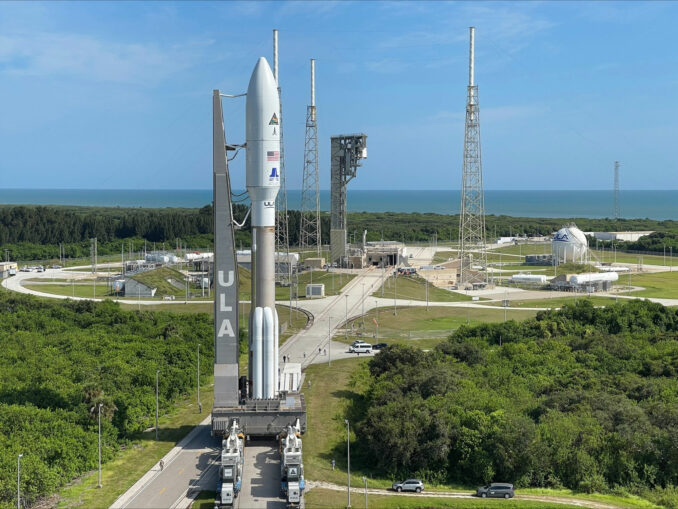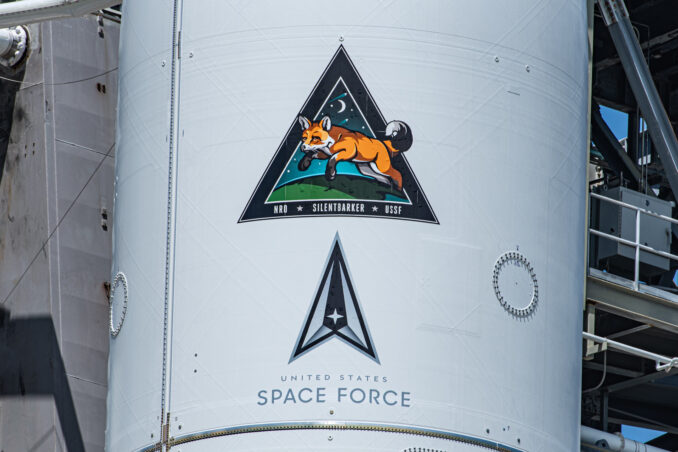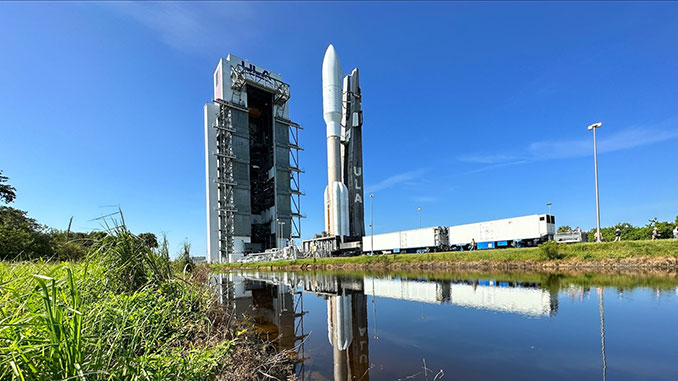Space News & Blog Articles
Atlas 5 rocket returns to pad for spy satellite agency launch from Cape Canaveral

United Launch Alliance’s Atlas 5 rocket made its way back to the pad at Space Launch Complex 41 at Cape Canaveral Space Force Station on Thursday morning for a mission carrying national security mission payloads, collectively codenamed Silentbarker. The 45th Weather Squadron’s launch weather forecast shows conditions are 85 percent favorable for liftoff at 8:51 a.m. EDT (1251 UTC).
While the National Reconnaissance Office (NRO) tends to remain mum about much of its operations and missions, the agency hosted a pre-launch press conference on Aug. 28 with its director, Dr. Christopher Scolese, appearing alongside ULA President and CEO Tory Bruno and the commander of U.S. Space Systems Command, Lt. Gen. Michael Guetlein, to talk about the mission and take questions from the press.
Asked why the NRO wanted to be more forthcoming with this mission, Scolese said they felt that sharing information about the Silentbarker mission is important to help better inform the U.S. public about the scope of the NRO’s operations beyond its national security implications.
“We want to let people know, to some extent, what our capabilities are and this is one capability that, if you think about it, has great value beyond just the national security community,” Scolese said. “The NRO supports more than just the national security community, the Department of Defense (DoD) and the Intelligence Community (IC). It also supports the civil community.”
Guetlein added that discussing some of their capabilities is also an important tool that can be used as deterrence with respect to adversaries of the United States.
“A huge part of the Space Force mission is not only to defend, but to deter aggression. A huge element of deterrence is the ability for the adversary to know what we can and cannot see,” Guetlein said.
“So, we actually want our competitors to know that we have eyes in GEO [geosynchronous Earth orbit] and that we can see what’s happening in GEO. And not only are we going to maintain the custody and ability to detect what’s going on in GEO, but we’ll have the indications and warnings to know there’s something out of the normal occurring.”
SILENTBARKER/#NROL107 is a joint mission with @USSF_SSC supporting space domain awareness, but it’s just one of the many ways NRO supports a range of customers.
Dr. Chris Scolese noted how NRO also assists civil mission partners during a joint press conference last week. pic.twitter.com/oWNe8GiEba
— NRO (@NatReconOfc) September 7, 2023
The Atlas 5 was originally intended to launch Tuesday, Aug. 29 on the Silentbarker mission, which is also known as NROL-107. While the weather would’ve been ideal for launch for the launch that morning, had there been a scrub because of technical issues, ULA would not have had sufficient time to roll the rocket back to the Vertical Integration Facility (VIF) before any impacts from Hurricane Idalia were felt in Florida. Bruno said it takes about 24 hours to off-load all the propellants from a fully-fueled Atlas 5 rocket to roll it back to the VIF.
What is Silentbarker?
The NROL-107 mission is part of what the U.S. Space Force describes as a “space domain awareness architecture to focus on deterring and defending against attempts to negate our critical space capabilities,” according to a May 2023 budget document presented to the U.S. Senate Subcommittee on Strategic Forces.
According to an unclassified U.S. Air Force budget document, Silentbarker was created as a partner program between the NRO and Air Force Space Command (now Space Force).
The program was designed to replace the Space-Based Surveillance (SBSS) Block 10 satellite, which launched on Sept. 25, 2010, from Vandenberg Air Force Base (now Vandenberg Space Force Base) using a Minotaur IV rocket.
Prior to partnering with the NRO, the Air Force labeled the program as the SBSS Follow-On (SBSS FO) program.
The document describes Silentbarker as such:
“Silentbarker will provide the capability to search, detect, and track objects from a space-based sensor for timely custody and event detection. Surveillance from space augments and overcomes existing ground sensor limitations with timely 24-hour above-the-weather collection of satellite metric data only possible with a space-based sensor and then communicates its findings to the Combined Space Operations Center (CSpOC), National Space Defense Center (NSDC), and other classified users. This program element includes efforts related to Silentbarker, its integration into the broader space superiority architecture, and analysis and experimentation to ensure space-based space surveillance capabilities against the evolving threat.”
Scolese said Silentbarker can be thought of as a “watchdog” within geosynchronous orbit, which is the space between 24,000 and 40,000 kilometers away from the Earth’s surface.
“You’ve heard about communication satellites moving from one location to an other to provide better coverage for other areas. Certainly, we want to be able to see that, so we know what is going on in that area,” Scolese said. “But we also want to know if there is something going on that is unexpected or shouldn’t be going on that could potentially represent a threat to a high-value asset, either ours or one of our allies’.”
Guetlein described Silentbarker as being an important leap forward when it comes to technology and observational capability.
“Today, we primarily rely on our ground-based radars. Our ground-based radars are pretty exquisite, but they can pretty much only see about a basketball-sized object in space. And because of the challenges of day, night and weather, it gets extremely hard to maintain custody of those objects,” Guetlein said.
“So, by actually moving the sensor into orbit with those objects, we can actually not only detect smaller objects, but maintain custody of them. And when they operate out of the norm, we get indications and warnings that there’s something here.”
Guetlein further clarified that the data collected would come into the National Space Defense Center (NSDC) and the satellite itself would be maintained by the NRO.
He said the “DoD will use this data to maintain the space catalog and provide that space catalog free to not only our commercial partners, but our international partners.”
“This data will allow us to have a better defined space catalog of the objects in geosynchronous orbit and of what the behavior of those objects is,” Guetlein said.
Silentbarker history and future
The mission’s development began roughly five years ago when both the NRO and the Space Force decided they needed better insight into the territory of geostationary orbit, Scolese said. The satellites had a roughly three-year development period.
“We both needed to know what was going on in GEO and it was really a perfect match because the owner was really good at building satellites for ISR (intelligence, surveillance and reconnaissance) and what we were really asking for was an ISR satellite in GEO to not only detect, but to maintain custody of what was happening in GEO,” Guetlein said.
“So, by leveraging the NRO’s mission domain experience in ISR, as well as their acquisition authorities in partnership with Space Force’s ability to have assured access to space, it really was a great partnership.”
The Silentbarker program is expected to consist of at least two launches, according to Scolese, “and perhaps more as satellites age out.” While he wouldn’t confirm how many payloads are on this first mission, he said the Sept. 9 Atlas 5 launch will include “multiple payloads.”
After its launched, Scolese said it will take between 30 to 90 days for a checkout phase before they can get into operations.
As for the second launch, Scolese said that “future launches may or may not have multiple payloads.”
According to a FY2021 Air Force budget document, the SBSS FO Expanded Coverage mission was expected to have completed its critical design review by the end of 2021 and become available for launch in 2024.
An April 2023 report from the U.S. Government Accountability Office (GAO), a non-partisan agency providing information on government operations to Congress, stated that the Silentbarker program is expected to reach full operational capability (FOC) in FY2026.
Cost of protecting space assets
A FY2021 Air Force assessment of the Silentbarker program laid out cost elements through FY2025 and estimated the total cost to be $1,189,788,000.
The GAO’s April 2023 report, entitled “Space Situational Awareness – DoD Should Evaluate How it Can Use Commercial Data,” estimated that the Silentbarker program would cost $994 million.
While officials during the Aug. 28, 2023, press briefing declined to go into detail regarding any of the companies who were contracted to work on Silentbarker, some information has been shared publicly.
A list of U.S. Department of Defense contracts dated June 15, 2021, included an Air Force contract to L3Harris Technologies Inc., which received $8,091,846.29 to work on an element of Silentbarker.
 A closeup view of the mission patch for the Silentbarker/NROL-107 mission painted on the Atlas 5 payload fairings. The mission is targeting liftoff from SLC-41 at Cape Canaveral Space Force Station at 8:51 a.m. EDT on Sept. 9. Image: Michael Cain/Spaceflight Now
A closeup view of the mission patch for the Silentbarker/NROL-107 mission painted on the Atlas 5 payload fairings. The mission is targeting liftoff from SLC-41 at Cape Canaveral Space Force Station at 8:51 a.m. EDT on Sept. 9. Image: Michael Cain/Spaceflight Now
The nearly $8.1 million was described as a contract modification to pay for work on the “Silentbarker Retina effort under the Combat Mission Systems Support program.”
“The contract modification is intended to mature and operationalize the mission development processor prototype under the current program and to provide additional capabilities to the operational Retina. Work will be performed in Colorado Springs, Colorado, and is expected to be completed June 16, 2022,” according to the contract award summary.
Launch of the Silentbarker mission was awarded to United Launch Services, LLC., a subsidiary of ULA, as part of a three-launch service contract under the Phase 1A Evolved Expendable Launch Vehicle (EELV) procurement strategy.
The EELV was renamed the “National Security Space Launch” program in March 2019.
The contract announcement didn’t parse out the value of each launch, but did put the collective value of the Silentbarker mission along with the previously launched SBIRS GEO-5 and SBIRS GEO-6 missions at about $441.76 million.
Silentbarker was originally announced with a target launch date during FY2022.
Closing of a chapter
As ULA prepares to retire the Atlas 5 rocket, the Silentbarker mission will mark one of 19 remaining flights of that vehicle.
While the company still has one more national security mission using the Atlas 5, USSF-51, which is targeting launch sometime in 2024, the Sept. 9 launch will be the final Atlas 5 supporting a mission for the NRO.
Once complete, the Atlas 5 will have flown 18 NRO missions. Bruno described the moment as “bittersweet,” but said capping off this journey with the Atlas 5 551 configuration is exciting.
“It’s our mission that we’re designed for, so it’s kind of a fitting way to end that,” Bruno said. “It means a lot to our guys. You’re going to see people with a little tear in the corner of their eye.”
The 551 designation denotes the use of five solid rocket boosters, which are strapped to the Atlas first stage. This rocket will also use ULA’s biggest payload fairing, which is their Long 5-meter diameter set. This configuration is nicknamed “Bruiser” for public relations purposes by ULA.

In its history, ULA has launched 97 national security missions, of which, 33 were for the NRO, using various launch vehicles.
Bruno says this is an exciting sendoff as the company prepares to retire both the Atlas 5 and Delta 4 Heavy rockets and transition to exclusively the forthcoming Vulcan rocket.
“Personally, this mission means a lot to me, as it does to everyone on your teams, I’m sure,” Bruno said, referring to Scolese and Guetlein. “There are folks out there working very hard every day to make Earth orbit a rough neighborhood and this and this is going to do a lot to keep the safe, high ground the peaceful high ground that it was meant to be.”
When you subscribe to the SpaceZE News Feed, we will send you an e-mail when there are new updates on the site so you wouldn't miss them.

